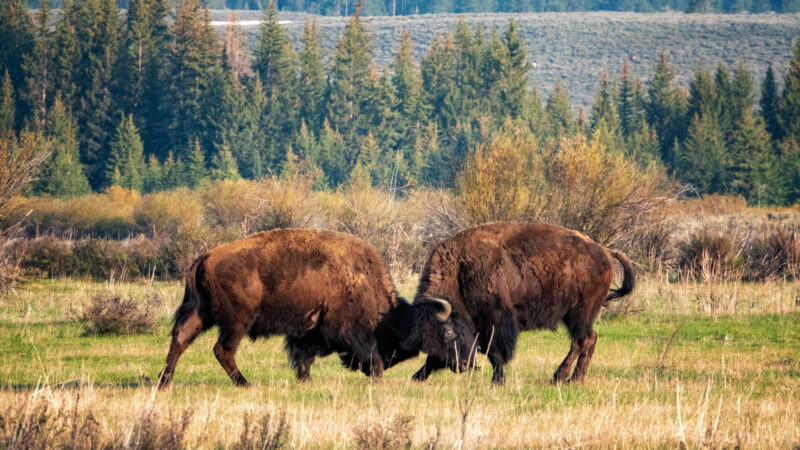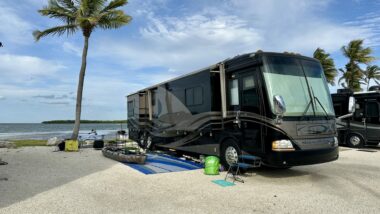Table of Contents Show
Millions of visitors flock to Yellowstone National Park every year. Sadly, some leave in much worse condition than when they arrived.
Visitors often disregard warnings from rangers and park officials to keep their distance from bison. However, it seems every other day we see a viral video of a close encounter with one of these massive beasts. Unfortunately, not all are close calls, and animals rarely lose these fights.
So how many bison attacks happen in Yellowstone? Lace up your hiking boots, and let’s see.
About Yellowstone National Park
In 1872, Yellowstone National Park became the first national park established in the United States.
While it’s primarily in Wyoming, small portions spill over into the neighboring states of Idaho and Wyoming. Its approximately 2.2 million acres are home to geothermal features, wildlife, and incredible landscapes.
Some of the most popular attractions within its boundaries are the geysers, hot springs, mud pots, and fumaroles. These geothermal features create an experience unlike most tourists have ever experienced. It can feel like exploring a new planet.
However, the natural wonders aren’t all it offers. As we mentioned, it’s not uncommon to see bison freely roaming. In addition, you may hit the jackpot and see grizzly bears, gray wolves, elk, moose, or pronghorn sheep.
You can also watch the skies to see bald eagles, ospreys, and trumpeter swans.
Many travelers have Yellowstone on their bucket list. It’s a playground for any adventurer ready to explore the great outdoors. However, like any outdoor setting, you can’t take it lightly. Having a healthy dose of respect for the power of the elements and wildlife is essential.
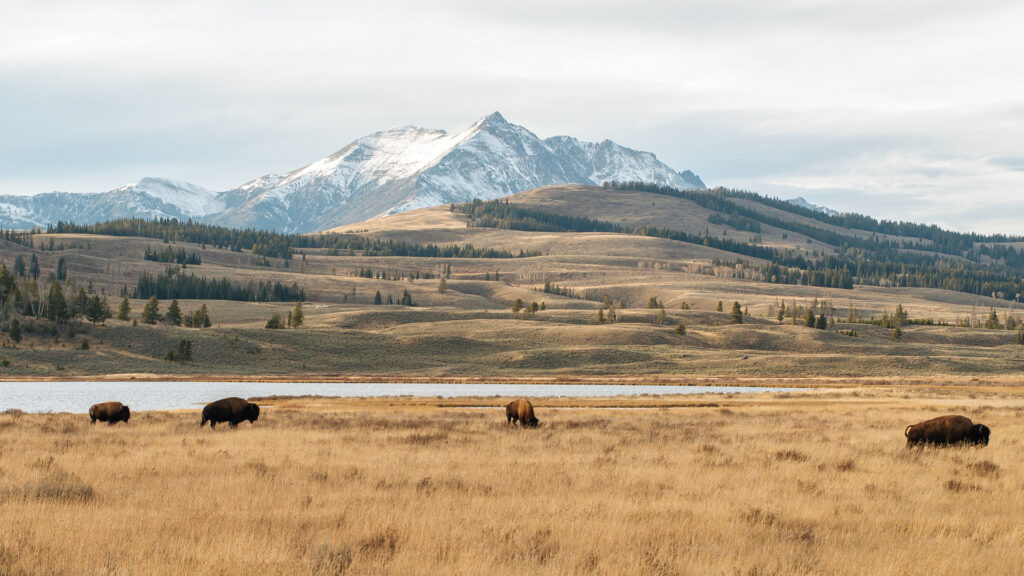
Why Do Bison Attack People?
Despite their calm, docile, and somewhat cuddly appearance, bison can and do attack people. Just like humans, the grumpy ones often distance themselves from the rest. It doesn’t take much to anger these beasts.
Typically, when we hear reports of attacks on people, it’s often because the tourists got too close. In our social media-driven world, many want to see how close they can get when taking selfies. Unfortunately, one of the worst things you can do is get close and turn your back on a wild animal.
Additionally, some attacks are simply the result of being in the wrong place at the wrong time. You could walk around the corner on a trail and discover a bison.
It gets worse if it’s calving season and you’ve put yourself between them and their baby. Like any good parent, they’ll do anything to protect their young.
When they identify you as a threat, it’s only a matter of time before they attack. Surprisingly, these 2,000-pound fur balls can run up to 35 miles an hour. You can’t outrun these giant creatures, no matter how fast you were in your glory days.
How Many Bison Attacks Happen in Yellowstone?
In general, one or two bison attacks occur yearly. Considering three million people visit Yellowstone annually, the number of attacks is incredibly low. While there have been many close calls, the first bison attack in 2023 occurred on July 17.
As a result of the attack, a 47-year-old woman from Arizona was airlifted to Eastern Idaho Regional Medical Center. Officials aren’t sure how close the woman got, but she had turned to walk away from the animal when it charged.
This was the first attack in more than a year. The last reported incident occurred on June 28, 2022.
How to Stay Safe from Bison
Yellowstone isn’t the only spot with herds of bison. You can also find them at national parks like Grand Teton, Theodore Roosevelt, Badlands, and Wind Cave.
No matter where you see them, here are a few tips for how to stay safe from bison.
Keep Your Distance
You should never purposefully approach any wildlife, especially bison. Officials warn visitors to stay at least 25 yards away. Posted signs remind guests of the rules.
Even if an attack doesn’t happen, purposefully ignoring this warning often results in serious consequences. The National Park Service (NPS) takes these situations very seriously. Violators have received fines, jail sentences, and bans for getting too close.
Remember, we mentioned earlier that these large creatures can run up to 35 miles per hour. Even with a 25-yard headstart, it won’t take long for them to catch you. It’s best to keep your distance.
Stay in Your Vehicle
It’s not uncommon for visitors to experience bison along roads. When this occurs, stay in your vehicle and proceed slowly. If it’s in the way, you’ll have to wait for it to move. If you experience a random traffic jam, it likely results from a stubborn animal.
Being in a vehicle doesn’t exempt you from keeping your distance. Honking or trying to use your car to move it out of the way is a bad idea.
It’ll likely agitate it and could cause it to attack your vehicle or someone else’s. You’ll end up paying your insurance deductible and likely an NPS fine.
Keep in Mind: Wildlife isn’t the only thing you should keep your distance from. This Tourist Touched a Hot Springs in Yellowstone and learned a painful lesson!
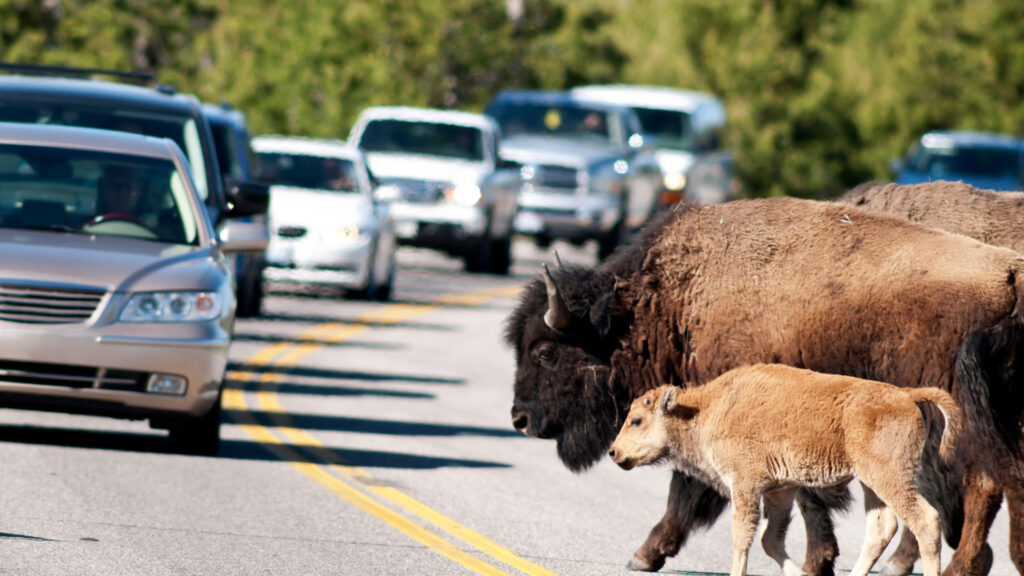
Keep Dogs Under Control
If you’re traveling with a dog, you must keep it under control. While many areas prohibit dogs on trails, you can have your pet in certain areas.
Unfortunately, a dog barking may be enough to aggravate the bison’s already unpredictable behavior. There’s no telling how it will respond. While they may not bark, their horns can have a serious bite.
Respect Park Closures or Warnings
It’s not uncommon for officials to issue closures and warnings. These warnings protect animals, humans, and the habitat. Whatever the reason, you must respect the closures and warnings. If not, you could put yourself and your bank account in danger.
Warnings are not only for keeping your distance but also for how to store food and various other situations. Unfortunately, regulations depend on the location.
We suggest reading the materials officials give you when you enter. Familiarize yourself with the rules so you stay on the right side of the law.
Do Not Feed Them
One of the worst things you can do is feed wild animals. Not only is this illegal, but it puts yourself, the creature, and other visitors in danger. Unfortunately, this is one rule that we frequently see people ignore.
Feeding them can be dangerous because it teaches them to depend on humans. They begin to see all humans as a place where they can score a bite to eat.
The different diets between humans and nature can cause health complications for the animal. In addition, future guests may not have any food to share. The animal might even attack them out of frustration.
Make Noise
While you may enjoy a quiet hike in nature, it’s best to make some noise. Doing so can alert wildlife of your presence so you avoid surprising them. The last thing you want to do is surprise a grumpy bison. If you do, you could end up on the receiving end of a horn.
You’ll likely naturally carry on conversations if hiking in a larger group. However, if you go solo or in a small group, you can wear bells to avoid surprising wildlife. You can never be too safe when out in the wild.
Keep in Mind: Bison aren’t the only animals you might encounter in Yellowstone! Make sure you know what to do if you encounter a bear.
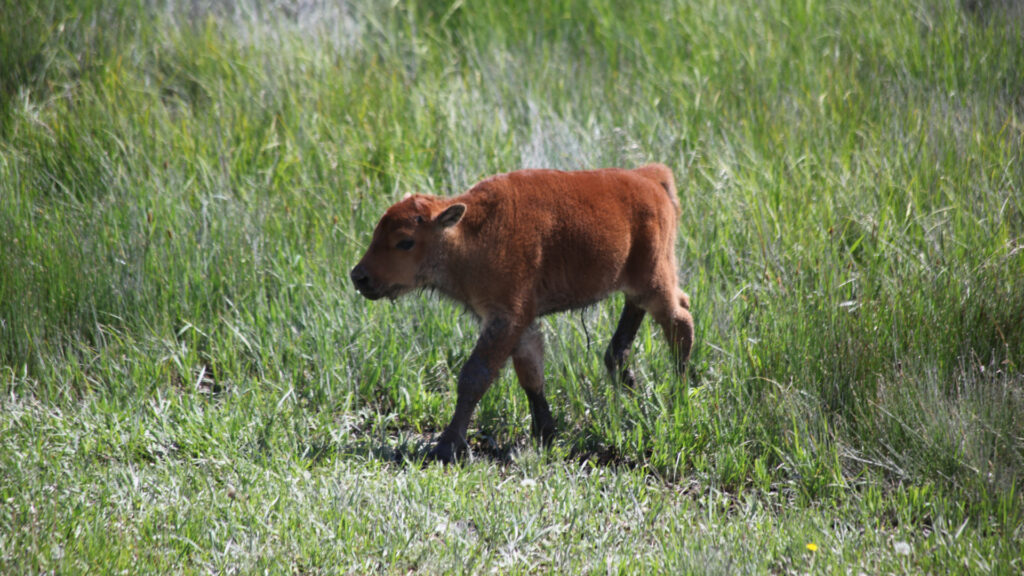
Do Not Run
We understand that encountering wildlife can be scary. However, running is typically a downright terrible idea. This can cause an involuntary reaction from the wildlife to chase you down. Again, you won’t stand a chance in this race.
Your best bet is to back away slowly and not make any quick movements. You don’t want to cause a worse situation by trying to escape.
Be Aware of Bison Attacks in Yellowstone National Park
If you follow some common sense steps, there’s a good chance you’ll leave Yellowstone National Park unharmed. However, many people ignore the warnings and endanger themselves and others.
Do yourself and park officials a favor and enjoy the bison from a safe distance. If you want an up-close look, invest in a quality zoom lens for your camera.
Have you seen the bison roaming Yellowstone National Park?




